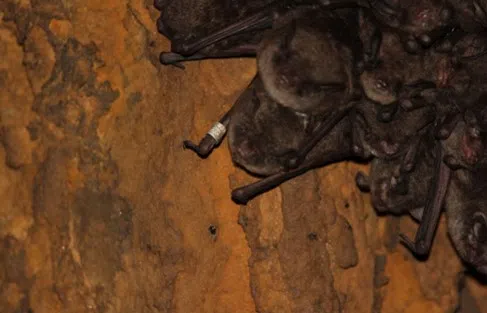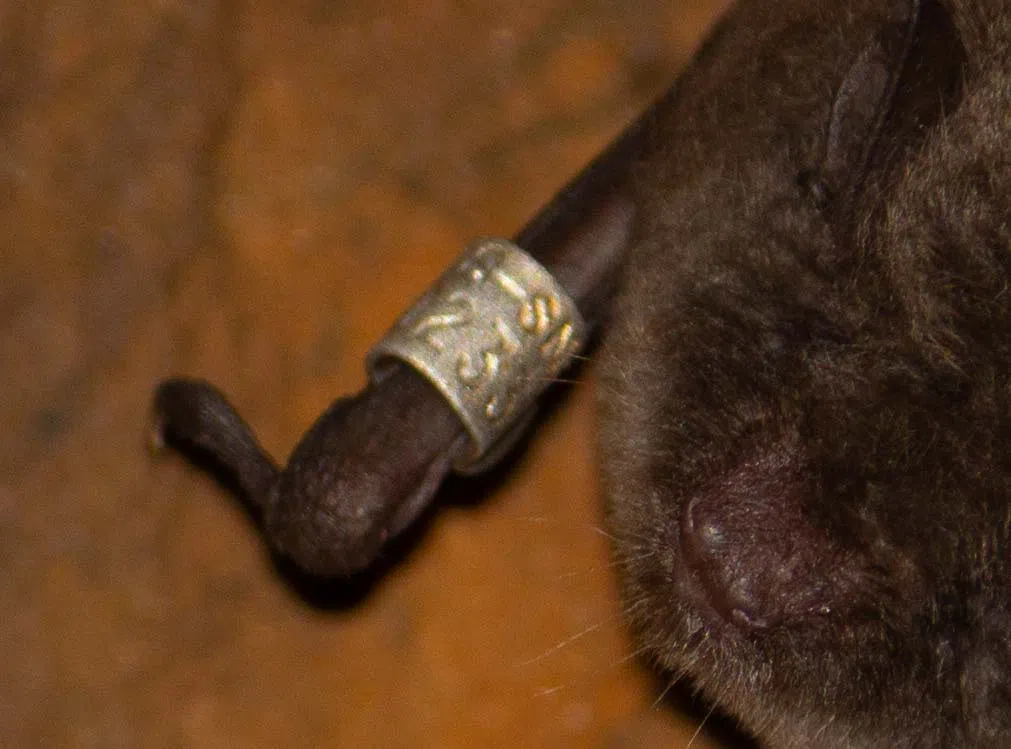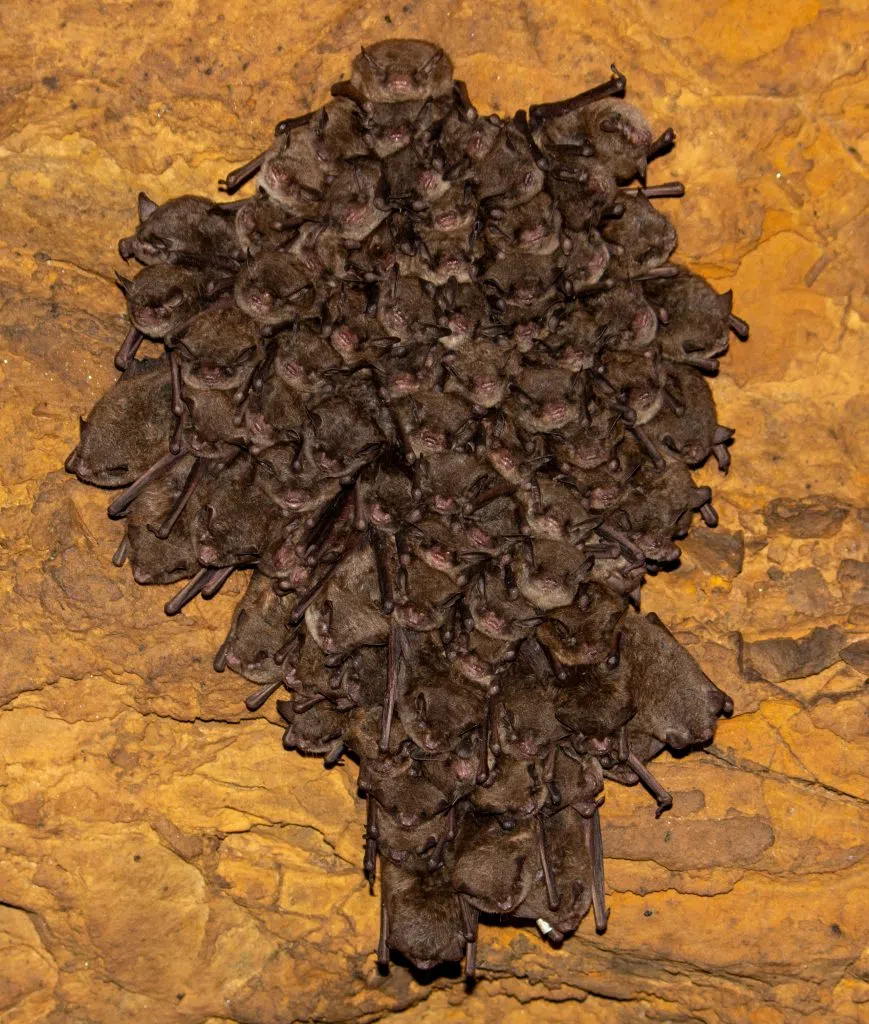Bat Surveys Critical to Guiding Future Management Practices
HARRISBURG, IL, March 15, 2024— During a recent bat survey, Shawnee National Forest wildlife biologists discovered an old friend, a bat previously banded during a bat survey from more than 15 years ago.
“This adult male Indiana bat was captured and banded on October 5, 2009, at a cave entrance in Pope County, then resighted and photographed February 15, 2024, at the same cave, but inside during a winter bat hibernacula (habitat) survey,” said Mark Vukovich, wildlife biologist with Shawnee National Forest. “This is the oldest known bat recorded on the [forest] since bat surveys started in the 1990s. It’s also significant because the bat was banded before white-nose syndrome was documented here.”
White-nose syndrome would later be discovered at this cave in 2013, meaning this recently surveyed bat persisted through the deadly disease.
Vukovich added work done in the early 2000’s by Shawnee National Forest employees and partners have protected critical winter bat hibernation sites, using gate installations and instituting closure orders in survey areas to effectively eliminate human disturbance and ensure the safety and recovery of listed bats.
“The Shawnee National Forest has played an integral and historically important role in the early discovery, knowledge, and management of the Indiana bat in the state of Illinois and the Midwest,” Vukovich said. “The discovery of a maternity colony of Indiana bats in Jackson County on the Shawnee was first announced in 1987 and subsequent work documented a colony in Jackson County on the forest in 1999.”
Since that time, seven more maternity colonies, sites where female bats give birth, nurse and wean their pups, have been discovered by U.S. Forest Service biologists and state biologists on the Shawnee; and now the Shawnee has documented among the oldest known Indiana bats in the Midwest, the oldest ever on the forest, and possibly the oldest known bat in Illinois.
“In sum, the Shawnee National Forest, its wildlife program, and partners conduct some of the most important work on the Indiana bat among the national forests when it comes to the Indiana bat,” Vukovich said.
Bat surveys
Shawnee National Forest biologists have conducted bat surveys officially since 2006. Before that, Southern Illinois University (SIU) researchers, along with forest and state biologists, conducted bat surveys in the early 2000s and 1990s.
“There are two kinds of bat surveys conducted by Shawnee National Forest biologists, winter bat [hibernation site] surveys and summer mist-net surveys,” Vukovich said. “Summer mist-net surveys on the forest are typically conducted annually…and winter bat surveys are conducted every two years.”
In this instance, the Indiana bat, first banded in 2009, was discovered during a winter bat survey. Winter bat hibernation site surveys are critical in informing U.S. Fish and Wildlife Service (USFWS) on the current statuses of listed, or potential future listings, of bats.
During these winter surveys, Shawnee National Forest biologists survey caves for bats to identify and count individuals using standardized techniques.
“Bats can be difficult to identify so [forest] biologists use photography to assist in identification and counting,” Vukovich explained. “For example, the Indiana bat forms tightly packed clusters, and by using photography, pictures of clusters can be uploaded into computer programs to be enhanced and/or lightened, which can improve accuracy in the counts by using graphics to count the noses of the bats.”
Vukovich said that summer mist-net surveys, while conducted annually, can also be directly related to compliance of the Endangered Species Act of 1973. For example, when the Shawnee National Forest plans or conducts timber harvests, forest biologists, along with USFWS biologists, must determine whether the area contains suitable habitat beforehand and, if so, determine the degree or effort of survey needed to determine the presence or absence of the Indiana bat or the northern long-eared bat.
The U.S. Forest Service biologists set out mist-nets in travel corridors of bats, in hopes of capturing and radio-tagging individuals for a set number of nights. When individual bats are radio-tagged, the forest biologists then track them to roosts, which are typically dead large-diameter hardwood trees, but sometimes live trees (i.e. shagbark hickory).
Forest biologists watch and count bats emerging from the roost at dusk. All documented roosts in these surveys are then protected during timber harvests. This kind of information gathered by Shawnee National Forest biologists can be used to guide future management decisions, future forest biologists, researchers, and the USFWS.
Vukovich added that forest biologists use some of the newest technology available, like acoustic detectors, to find and identify important areas used by bats. Acoustic detectors can determine the timing of bat activity at certain sites on the forest as well.
“This helps management to adapt and make improvements over time,” he said. “Other breakthroughs in technology and bat monitoring are ongoing and the Shawnee National Forest uses these technologies to learn and understand more about bats here in southern Illinois.”
Additional forest management practices like timber harvesting and prescribed fires have also shown positive benefits for bats habitats.
“Disturbance from forest management activities may have neutral to beneficial effects on the federally endangered Indiana bat,” Vukowich explained. “For example, researchers found significantly greater overall bat activity within areas that had recent timber harvests versus areas that did not have harvests. Furthermore, Indiana bats have been shown to prefer to forage in areas after prescribed-fire operations in oak-hickory forests. Male Indiana bats were either positively or neutrally affected by prescribed burns while selecting roosts in Arkansas. In sum, active forest management has been shown through science to have neutral to beneficial impacts on Indiana bats.”
White-Nose Syndrome
The Eastern Region (Region 9) is home to 14 bat species, including the federally endangered Indiana bat, gray bat, and Virginia big-eared bat. Until recently, many of these bat species were thought to be thriving throughout the Eastern Region. And then, White-Nose Syndrome (WNS) was discovered.
White-Nose Syndrome is a disease that affects bats as they hibernate in caves and mines. This disease was previously unknown in North America and has spread very quickly across the Eastern Region.
First documented in New York in the winter of 2006-2007, WNS has spread rapidly across parts of the United States and Canada killing over 6 million bats in just six years. Bats have been found sick and dying in unprecedented numbers in and around caves and mines. In some locations, more than 90 percent of bats have died.
The continued spread of this disease poses a considerable risk to millions of other bats that have not yet been exposed to the disease. Bats are an essential, beneficial part of ecosystems. Bats play critical roles in insect control, plant pollination, seed dissemination, and cave ecosystems. Some research even suggests that bats could save agriculture more than 3 billion dollars in pest control every year simply by eating insects. White-Nose Syndrome has the potential to affect all off these important environmental functions.
White-nose syndrome was named for the fuzzy white fungus that is commonly visible on the muzzle, ears, and wings of affected bats. Scientists identified a previously unknown species of cold-loving fungus Pseudogymnoascus destructans as the cause of WNS. P. destructans thrives in low temperatures (40-55 F) and high humidity – conditions commonly found in caves and mines in the Eastern Region. Nine national forests in the Eastern Region possess caves or abandoned mines with winter bat habitat. Access to these sites has been restricted since 2009 to slow-the-spread of WNS, either through Forest-level closure orders or by structures such as bat-friendly gates.
To learn more about bats on the national forests visit www.fs.usda.gov/visit/know-before-you-go/bats.
A cluster of Indiana bats are photographed in a Pope County cave on the Shawnee National Forest during a recent winter hibernation site survey. The small white/silver mark standing out at the bottom of the cluster is a band on a bat that was recently discovered to have been originally banded during a bat survey in 2009. After being verified as an authentic band, it was discovered this male bat is the oldest known bat recorded on the Shawnee National Forest since bat surveys began in the 1990s. U.S. Forst Service photo.

This banded Indian bat was recently discovered to be the oldest known bat recorded on the Shawnee National Forest. The adult male bat was photographed during a winter hibernation site survey last month in a Pope County cave on the Shawnee National Forest. It was confirmed that the bat was banded in October 2009 by Rod McClanahan, Steve Widowski, Megan York, and Bob Lindsey. U.S. Forest Service photo.

An Indian bat photographed during a recent winter hibernation site survey in a Pope County cave on the Shawnee National Forest was recently confirmed to have been originally banded during a bat survey in 2009. Biologists carefully made out the last three digits of the band, #233, and the letters “SN” for Shawnee National Forest. After being verified as an authentic band, it was discovered this male bat is the oldest known bat recorded on the Shawnee National Forest since bat surveys began in the 1990s. U.S. Forst Service photo.










Comments